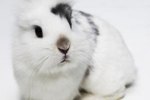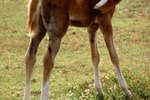
Probably nothing is more painful to a bovine than hoof lameness. Approximately 10 percent of dairy cows are culled -- sent to slaughter -- because of lameness issues. Abnormal foot growth, in which the hoof curves upward, is among the most obvious reasons for lameness. Unfortunately, the long-term prognosis for common causes of upward feet curvature is not promising.
Introducing Corkscrew Claw
In veterinary language, bovine hooves are referred to as claws. Usually occurring in the rear legs of cattle over the age of 3.5 years, corkscrew claw generally affects both hind hooves. Animals suffering from corkscrew claw develop screwlike horny growths on the end of the hoof that head inward and upward. Affected animals appear obviously lame because their weight is borne on the hoof's outer wall rather than the sole.
Correcting Corkscrew Claw
Correcting corkscrew claw requires a skilled bovine hoof trimmer. Whether you choose to correct a corkscrew claw or cull your affected animal is a personal decision. No real cure exists for the condition. The corkscrew section of the claw horn is hard; cutting it takes considerable time. The trimmer must shorten the hoof as much as possible without causing the toe to bleed. If that's accomplished, the trimmer must try to shape the foot to look as normal as possible. While good trimming might help the cow move about more freely, the abnormal growth will recur without careful attention.
Genetic Tendencies
A genetic link appears to exist to the development of corkscrew claw. Since it affects mature cattle, it is more likely to be seen in breeding bulls and cows -- as non-breeding cattle are usually slaughtered before the age in which the issue develops. The University of Illinois Extension website states that Jersey cows are less prone to corkscrew claw than other dairy breeds. Of the common dairy breeds, brown Swiss have the highest incidence of the hoof disorder.
Slipper Foot
Cattle suffering from chronic laminitis might develop slipper foot -- so named because of the hoof's resemblance to a Persian slipper, according to the "Merck Veterinary Manual" website. Laminitis in cattle involves abrupt changes to the interior of the claw, usually the result of grain overload. In slipper foot, the hoof curls up, although the end is square. The website says "treatment is disappointing" because of the hoof's inherent weakness and recommends that animals suffering from slipper foot should be culled "as soon as economically appropriate."
References
- Merck Veterinary Manual: Disorders of the Claw Capsule in Cattle
- Hoof Trimmers Association: Claw Lesions, Diseases, and Manifestations
- University of Illinois Extension: Genetic Associations for Corkscrew Claw, Interdigital Hyperplasia, Sole Ulcers and Heel Warts
- American Association of Bovine Practitioners: An Approach to Corkscrew Claw
- Merck Veterinary Manual: Overview of Lameness in Cattle
Photo Credits
-
Jupiterimages/Photos.com/Getty Images
Writer Bio
Jane Meggitt has been a writer for more than 20 years. In addition to reporting for a major newspaper chain, she has been published in "Horse News," "Suburban Classic," "Hoof Beats," "Equine Journal" and other publications. She has a Bachelor of Arts in English from New York University and an Associate of Arts from the American Academy of Dramatics Arts, New York City.




